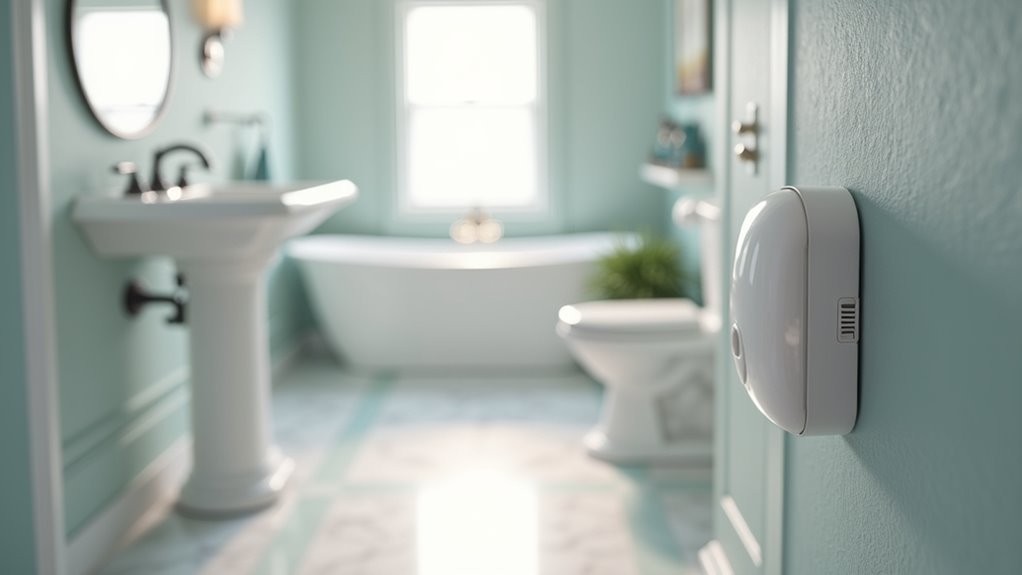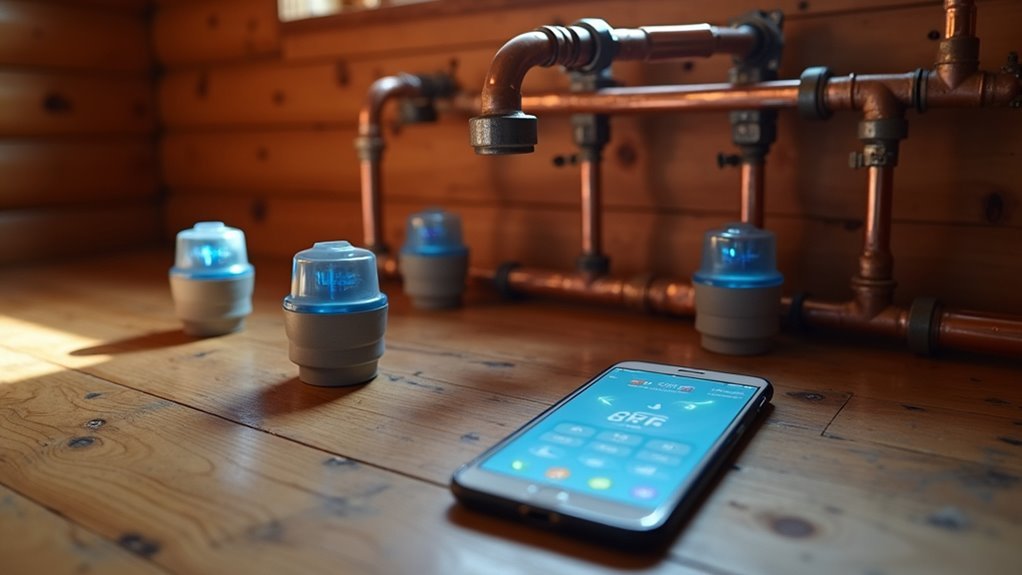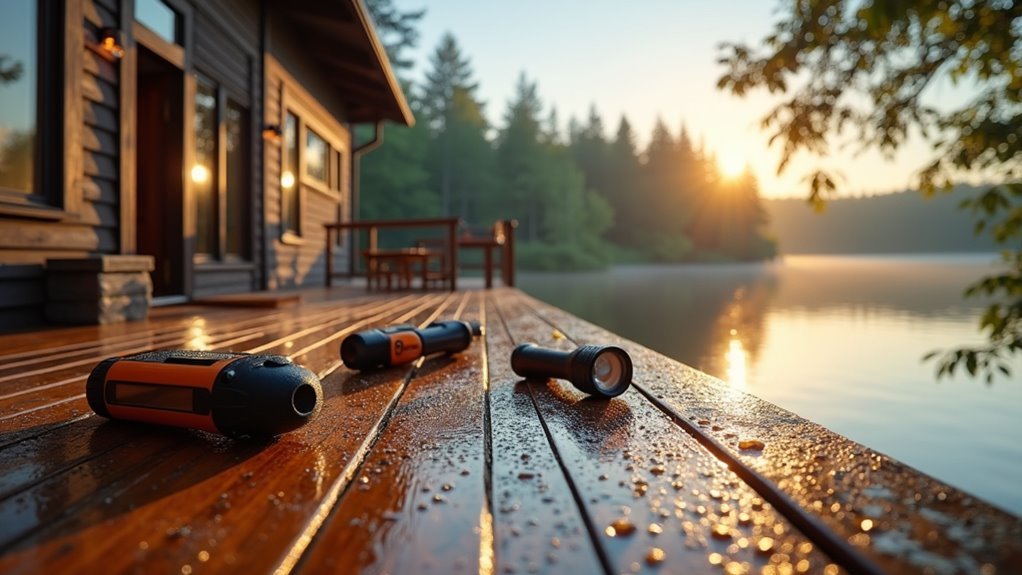You’ve invested significant time and money into your vacation home, but a single undetected water leak can destroy everything while you’re away. Whether it’s a burst pipe during winter or a slow drip that goes unnoticed for weeks, water damage doesn’t wait for your return. The good news is that modern technology offers reliable solutions to protect your property. However, choosing the right detection system and implementing it properly requires careful planning and strategic placement.
Install Smart Water Leak Detectors in High-Risk Areas

When protecting your vacation home from water damage, installing smart water leak detectors in high-risk areas serves as your first line of defense.
Position these devices in kitchens, bathrooms, and near appliances like washing machines and water heaters where leaks commonly occur.
The Govee system delivers real-time alerts through app and email notifications, ensuring immediate leak detection even when you’re away.
Stay connected to your property’s safety with instant notifications that reach you wherever you are, providing peace of mind during extended absences.
High sensitivity sensors effectively detect overflows and various water incidents, minimizing potential damage.
Installing multiple detectors provides extensive coverage throughout your property.
The Govee system supports up to 100 sensors for maximum protection.
Smart detectors with long-range connectivity utilizing LoRa technology can monitor hard-to-reach areas while maintaining reliable communication with the central system.
Choose Systems With Long-Range Connectivity for Remote Properties
When you’re protecting a remote vacation home, you’ll need leak detection systems with exceptional long-range connectivity that can reach across large properties and maintain reliable communication.
Standard Wi-Fi systems often fail in remote locations, making LoRa technology your best choice for achieving connectivity distances up to 1,300 feet between sensors and monitoring hubs.
You must assess your property’s specific coverage requirements to guarantee every high-risk area remains connected regardless of distance or potential signal interference.
LoRa Technology Range
Since vacation homes often sit in remote locations where Wi-Fi signals can’t reach, you’ll want leak detection systems equipped with LoRa technology that extends connectivity up to 1,300 feet.
This long-range connectivity guarantees your water leak detection system maintains reliable communication across your entire property without depending on internet access.
LoRa technology supports up to 100 leak detectors, giving you extensive coverage throughout multiple areas of your vacation home.
You’ll receive real-time alerts through both app notifications and email, keeping you informed of potential water damage even when you’re miles away.
This extended range capability provides the peace of mind you need when managing a remote property, guaranteeing consistent monitoring regardless of your vacation home’s isolated location.
Remote Property Coverage
Although vacation homes present unique monitoring challenges due to their remote locations and extended periods of vacancy, choosing leak detection systems with robust long-range connectivity guarantees you’ll maintain complete coverage across your entire property.
Smart water leak detectors with extended range capabilities ensure alerts reach you instantly, regardless of your cottage’s size or layout. Multiple sensor probes strategically placed throughout leak-prone areas provide thorough monitoring coverage.
Real-time monitoring through mobile apps keeps you connected to your property’s status, preventing minor leaks from becoming major disasters. Advanced monitoring systems designed for remote properties offer the reliability you need when managing vacation homes from afar.
This connectivity prevents the average $12,514 water damage losses that plague unmonitored properties.
Connectivity Distance Requirements
Long-range connectivity becomes the backbone of effective leak detection in remote vacation properties, where standard Wi-Fi signals often can’t reach every corner of your home.
You’ll need systems that maintain robust signal strength across extensive areas while supporting thorough monitoring through multiple sensors.
When evaluating connectivity distance requirements for your vacation home leak detection systems, consider these critical factors:
- LoRa Technology Range – Choose systems utilizing LoRa connectivity for distances up to 1,300 feet.
- Wi-Fi Network Stability – Verify your selected system maintains consistent remote monitoring capabilities.
- Sensor Capacity – Look for systems supporting up to 100 leak detectors for complete coverage.
- Real-Time Alerts – Verify mobile app notifications function reliably regardless of physical obstructions.
These specifications guarantee uninterrupted protection throughout your property.
Position Sensors Near Water Heaters and Plumbing Fixtures
Water heaters and plumbing fixtures represent the highest-risk areas in your vacation home, accounting for a considerable portion of the 22.98% of property losses caused by water damage.
You’ll want to position water leak sensors directly near these critical points where high water pressure and aging pipes create vulnerability. The GoveeLife detector’s high sensitivity and multiple sensor probes make it ideal for monitoring these fixtures in real-time.
Smart technology enables instant alerts through your app or email, ensuring early detection even when you’re away. This strategic placement can prevent property damage averaging $12,514 per incident.
Don’t forget to regularly check sensor positioning to maintain effectiveness, as proper placement around water heaters and plumbing fixtures considerably reduces severe water damage risks.
Set Up Real-Time Mobile Alerts and Email Notifications

When you’re miles away from your vacation property, real-time mobile alerts and email notifications become your first line of defense against catastrophic water damage.
You’ll receive immediate alerts through the Govee Home App whenever your leak detectors identify moisture threats.
Setting up effective notifications involves four key steps:
- Download the Govee Home App on your iOS or Android device for instant push notifications.
- Configure email notifications as a backup communication method for critical alerts.
- Customize alert settings to control notification frequency and avoid alert fatigue.
- Test connectivity range ensuring your detectors communicate effectively up to 1,300 feet via LoRa technology.
These immediate alerts enable quick responses that prevent extensive water damage and costly repairs, making them essential for protecting your investment.
Conduct Regular Plumbing Inspections Before Extended Absences
While mobile alerts provide excellent monitoring capabilities, prevention remains your most powerful tool against water damage. Conducting thorough plumbing system inspections before extended absences helps identify potential water leaks early. Check all faucets, fixtures, and toilet tanks for signs of leakage that could escalate into serious problems. Don’t overlook your water heater—inspect it carefully for corrosion or leaks that homeowners often miss.
| Inspection Area | Prevention Benefit |
|---|---|
| Faucets & Fixtures | Prevent water damage before it starts |
| Water Heater | Avoid costly corrosion-related failures |
| Gutters & Downspouts | Stop roof leaks during heavy rainfall |
These proactive measures greatly reduce repair costs, which average over $15,000 per incident. Regular inspection helps prevent insurance claims, as water damage accounts for 22.98% of vacation home losses.
Monitor Water Pressure and Usage Patterns Remotely

Beyond physical inspections, remote monitoring of water pressure and usage patterns gives you essential insights into your plumbing system’s health.
Smart leak detection systems provide invaluable protection for vacation homes through continuous surveillance.
Here’s how remote monitoring capabilities protect your property:
- Track excessive pressure levels – Monitor water pressure remotely to identify dangerous spikes above 60 psi that damage plumbing components and increase leak risks.
- Detect hidden leaks early – Water usage patterns reveal unusual spikes indicating concealed leaks or appliance malfunctions in washing machines and water heaters.
- Receive real-time alerts – Advanced systems notify you instantly about water flow and pressure changes, enabling prompt action before significant damage occurs.
- Analyze historical water usage data – Review trends and anomalies to proactively address potential leak sources and maintain peak plumbing health.
Ensure Proper Sensor Placement in Basements and Crawl Spaces
Since basements and crawl spaces represent your vacation home’s most vulnerable areas for undetected water damage, strategic sensor placement in these locations becomes critical for thorough leak protection.
Strategic water sensor placement in basements and crawl spaces provides essential protection for your vacation home’s most vulnerable areas.
You’ll want to position water leak sensors near moisture-prone areas where plumbing systems typically develop issues. Focus on placing sensors around water heaters, sump pumps, and washing machines—common leak sources that often go unnoticed during extended absences.
Install sensors directly on the ground or slightly elevated to accurately detect pooling water before it spreads.
In larger basements and crawl spaces, you’ll need multiple sensors to cover wider areas effectively. This approach guarantees early detection regardless of where leaks originate.
Remember to regularly check your sensors’ functionality, as malfunctioning devices can leave critical areas unmonitored.
Test Detection System Performance and Battery Life Regularly
After installing your leak detection system, you’ll need to establish a regular testing routine to confirm it performs reliably when water emergencies strike.
Your smart water leak detectors require consistent maintenance to guarantee functioning properly and provide early leak detection when you’re away.
Follow this routine inspection schedule:
- Test detection system performance monthly using simulated leaks to verify sensors respond correctly.
- Check battery life every six months, replacing weak batteries immediately to prevent detection failures.
- Monitor app notifications regularly for low battery alerts and system status updates.
- Utilize built-in test features to verify all components communicate effectively with your monitoring system.
Regular testing prevents costly water damage by confirming your leak detection system operates at peak performance throughout your vacation home’s unoccupied periods.
Integrate Leak Detection With Your Smart Home Security System
Connecting your leak detection system to your existing smart home security platform creates a unified monitoring solution that streamlines emergency response for your vacation property.
You can integrate smart water leak detectors with platforms like Amazon Alexa and Google Assistant for enhanced control and functionality. When you connect these systems, you’ll receive real-time notifications through push alerts, emails, or texts, keeping you informed regardless of your location.
Modern detectors offer temperature and humidity monitoring, helping identify freezing pipe risks before damage occurs.
Implementing extensive monitoring solutions through your smart home security system can reduce insurance premiums, as many insurers provide discounts for properties equipped with advanced leak detection technology.
Maintain Clear Communication Channels With Local Emergency Contacts
When a leak detection system alerts you to a problem at your vacation home, you’ll need reliable local contacts who can respond immediately.
Smart sensors can’t fix leaks themselves—they require human intervention to prevent costly damage.
Establish clear communication channels with your emergency contacts:
- Create a detailed contact list including neighbors, property management companies, and trusted friends who can access your vacation home quickly.
- Share your travel schedule and provide updates when plans change so contacts know when you’re away.
- Train contacts on your water leak detection system so they can interpret alerts and locate shut-off valves.
- Use group messaging apps to communicate real-time updates and coordinate emergency response efforts.
Regularly review and update contact information to guarantee reliable communication when emergencies arise.
Frequently Asked Questions
What Is the Best Method of Leak Detection?
You’ll get the best leak detection by combining traditional visual inspections with advanced smart monitoring systems. These provide immediate alerts, detailed usage reports, and can detect hidden leaks before they cause significant damage.
Do Water Leak Detectors Really Work?
Yes, water leak detectors work effectively. You’ll receive smartphone alerts when they detect pooling water, drips, or humidity changes. They’ve proven to reduce costly water damage claims and provide early warnings that protect your home.
Where Is the Best Location for a Water Leak Detector?
You’ll want to place water leak detectors near water heaters, washing machines, and in bathrooms where leaks commonly occur. Position them on floors where water pools and guarantee they’re within Wi-Fi range for alerts.
What Is the Most Effective Leak Detection Method According to the EPA?
You’ll find the EPA recommends combining visual inspections with advanced technologies like moisture meters and thermal imaging cameras. This dual approach effectively identifies both visible and hidden leaks throughout your property.





Leave a Reply